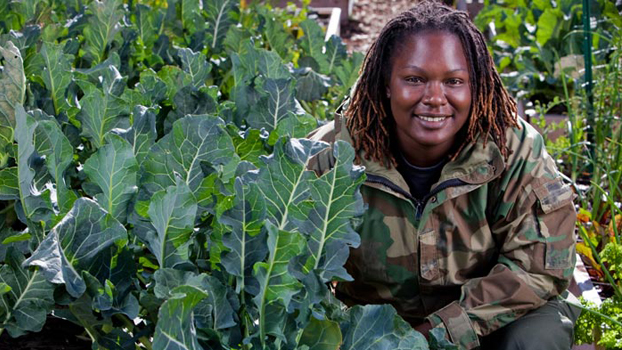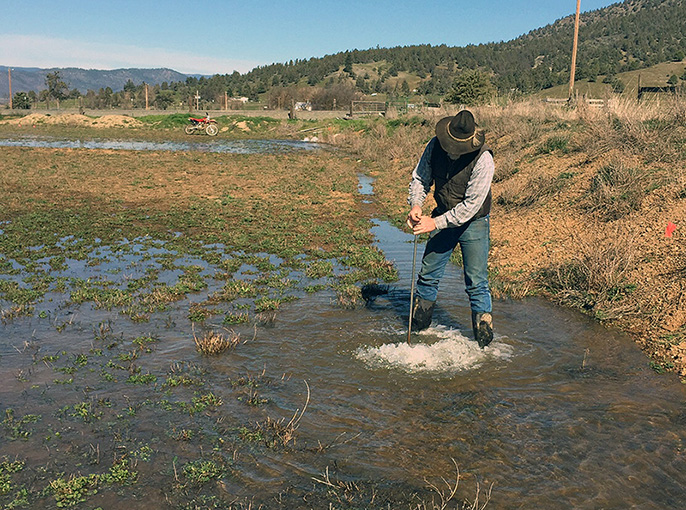The U.S. Department of Agriculture (USDA) reminds farmers and ranchers affected by the recent wildfires in Alaska, California, Idaho, Montana, Oregon and Washington State that USDA has programs to assist with their recovery efforts.
The Farm Service Agency (FSA) can assist farmers and ranchers who lost livestock, grazing land, fences or eligible trees, bushes and vines as a result of a natural disaster. FSA administers a suite of safety-net programs to help producers recover from eligible losses, including the Livestock Indemnity Program, the Livestock Forage Disaster Program, the Emergency Assistance for Livestock, Honeybees, and Farm-Raised Fish Program, and the Tree Assistance Program.
In addition, the FSA Emergency Conservation Program provides funding and technical assistance for farmers and ranchers to rehabilitate farmland damaged by natural disasters and for carrying out emergency water conservation measures in periods of severe drought. Producers located in counties that received a primary or contiguous disaster designation are eligible for low-interest emergency loans to help them recover from production and physical losses. Compensation is also available to producers who purchased coverage through the Noninsured Crop Disaster Assistance Program, which protects non-insurable crops against natural disasters that result in lower yields, crop losses or prevented planting.
“Wildfires have caused devastating losses for many farmers and ranchers,” said FSA Administrator Val Dolcini. “Over the past several years, wildfires have increased in severity, intensity and cost as the fire season has grown longer, and drought and increased temperatures contribute to dangerous conditions. Natural disasters such as wildfires are unavoidable, but USDA has strong safety-net programs to help producers get back on their feet.”
The Natural Resources Conservation Service (NRCS) can assist producers with damaged grazing land as well as farmers, ranchers and forestland owners who find themselves in emergency situations caused by natural disasters. The NRCS Environmental Quality Incentives Program provides financial assistance to producers who agree to defer grazing on damaged land for two years. In the event that presidentially declared natural disasters, such as wildfires, lead to imminent threats to life and property, NRCS can assist local government sponsors with the cost of implementing conservation practices to address natural resource concerns and hazards through the Emergency Watershed Protection Program.
“After natural disasters such as wildfires, it is critical that farmers, ranchers and forestland owners have financial and technical resources available to protect their natural resources and operations,” said NRCS Chief Jason Weller. “Conservation practices protect the land and aid recovery, but can build the natural resource base and may help mitigate loss in future events.”
Farmers and ranchers with coverage through the federal crop insurance program administered by the Risk Management Agency (RMA) should contact their crop insurance agent to discuss losses due to fire or other natural causes of loss. Crop insurance is sold and delivered solely through private crop insurance agents. A list of crop insurance agents is available at all USDA Service Centers and online at the RMA Agent Locator.
When wildfires destroy or severely damage residential property, Rural Development (RD) can assist with providing priority hardship application processing for single family housing. Under a disaster designation, RD can issue a priority letter for next available multi-family housing units. RD also provides low-interest loans to community facilities, water environmental programs, businesses and cooperatives and to rural utilities.
For the first time in its 110-year history, the Forest Service, part of USDA, is spending more than 50 percent of its budget to suppress the nation’s wildfires.
Today, fire seasons are 78 days longer than in the 1970s. Since 2000, at least 10 states have had their largest fires on record. This year, there have been more than 46,000 fires. Increasing development near forest boundaries also drives up costs, as more than 46 million homes and more than 70,000 communities are at risk from wildfire in the United States.
Visit https://go.usa.gov/3eDeF to learn more about USDA disaster preparedness and response. For more information on USDA disaster assistance programs, please contact your local USDA Service Center. To find your local USDA Service Center go to http://offices.usda.gov.






 Dec. 20
Dec. 20 Jan. 03
Jan. 03 Jan. 10
Jan. 10 Jan. 17
Jan. 17 Jan. 24
Jan. 24 Jan. 31
Jan. 31 Feb. 07
Feb. 07 Feb. 14
Feb. 14 Feb. 21
Feb. 21 Feb. 28
Feb. 28 Mar. 06
Mar. 06 Mar. 13
Mar. 13 Mar. 20
Mar. 20 Mar. 27
Mar. 27 Apr. 03
Apr. 03 Apr. 10
Apr. 10 Apr. 17
Apr. 17 Apr. 24
Apr. 24 May 01
May 01 May 08
May 08 May 15
May 15 May 22
May 22 May 29
May 29 June 05
June 05 June 12
June 12 June 19
June 19 June 26
June 26 July 03
July 03 July 10
July 10 July 17
July 17 July 24
July 24 July 31
July 31 Aug. 07
Aug. 07 Aug. 14
Aug. 14 Aug. 21
Aug. 21 Aug. 28
Aug. 28 Sep. 04
Sep. 04 Sep. 11
Sep. 11 Sep. 18
Sep. 18 Sep. 25
Sep. 25 Oct. 02
Oct. 02 Oct. 09
Oct. 09 Oct. 16
Oct. 16 Oct. 23
Oct. 23 Oct. 30
Oct. 30 Nov. 06
Nov. 06 Nov. 13
Nov. 13 Nov. 20
Nov. 20 Nov. 27
Nov. 27 Dec. 04
Dec. 04 Dec. 11
Dec. 11 Dec. 18
Dec. 18 Dec. 25
Dec. 25 Jan. 01
Jan. 01 Jan. 08
Jan. 08 Jan. 15
Jan. 15 Jan. 22
Jan. 22 Jan. 29
Jan. 29 Feb. 05
Feb. 05 Feb. 12
Feb. 12 Feb. 19
Feb. 19 Feb. 26
Feb. 26 Mar. 05
Mar. 05 Mar. 12
Mar. 12 Mar. 19
Mar. 19 Mar. 26
Mar. 26 Apr. 02
Apr. 02 Apr. 09
Apr. 09 Apr. 16
Apr. 16 Apr. 23
Apr. 23 Apr. 30
Apr. 30 May 07
May 07 May 14
May 14 May 21
May 21 May 28
May 28 June 04
June 04 June 11
June 11 June 18
June 18 June 25
June 25 July 02
July 02 July 09
July 09 July 16
July 16 July 23
July 23 July 30
July 30 Aug. 06
Aug. 06 Aug. 13
Aug. 13 Aug. 20
Aug. 20 Aug. 27
Aug. 27 Sep. 03
Sep. 03 Sep. 10
Sep. 10 Sep. 17
Sep. 17 Sep. 24
Sep. 24 Oct. 01
Oct. 01 Oct. 08
Oct. 08 Oct. 15
Oct. 15 Oct. 22
Oct. 22 Oct. 29
Oct. 29 Nov. 05
Nov. 05 Nov. 12
Nov. 12 Nov. 19
Nov. 19 Nov. 26
Nov. 26 Dec. 03
Dec. 03 Dec. 10
Dec. 10 Dec. 17
Dec. 17 Dec. 24
Dec. 24 Dec. 31
Dec. 31 Jan. 07
Jan. 07 Jan. 14
Jan. 14 Jan. 21
Jan. 21 Jan. 28
Jan. 28 Feb. 04
Feb. 04 Feb. 11
Feb. 11 Feb. 18
Feb. 18 Feb. 25
Feb. 25 Mar. 04
Mar. 04 Mar. 11
Mar. 11 Mar. 18
Mar. 18 Mar. 25
Mar. 25 Apr. 01
Apr. 01 Apr. 08
Apr. 08 Apr. 15
Apr. 15 Apr. 22
Apr. 22 Apr. 29
Apr. 29 May 06
May 06 May 13
May 13 May 20
May 20 May 27
May 27 June 03
June 03 June 10
June 10 June 17
June 17 June 24
June 24 July 01
July 01 July 08
July 08 July 15
July 15 July 22
July 22 July 29
July 29 Aug. 12
Aug. 12 Aug. 19
Aug. 19 Aug. 26
Aug. 26 Sept. 2
Sept. 2 Sept. 09
Sept. 09 Sept. 16
Sept. 16 Sept. 23
Sept. 23 Sept. 30
Sept. 30 Oct. 07
Oct. 07 Oct. 14
Oct. 14 Oct. 21
Oct. 21 Oct. 28
Oct. 28 Nov. 4
Nov. 4 Nov. 11
Nov. 11 Nov. 18
Nov. 18 Nov. 25
Nov. 25 Dec. 02
Dec. 02 Dec. 09
Dec. 09 Dec. 23
Dec. 23 Jan. 06
Jan. 06 Jan. 20
Jan. 20 Feb. 3
Feb. 3 Feb. 10
Feb. 10 March 3
March 3 March 10
March 10 March 17
March 17 March 24
March 24 March 31
March 31 April 7
April 7 April 21
April 21 April 28
April 28 May 5
May 5 May 12
May 12 May 19
May 19 May 26
May 26 June 2
June 2 June 9
June 9 June 16
June 16 June 23
June 23 June 30
June 30 July 7
July 7 July 14
July 14 July 21
July 21 July 28
July 28 Aug. 4
Aug. 4 Aug. 11
Aug. 11 Aug. 18
Aug. 18 Aug. 25
Aug. 25 Sept. 1
Sept. 1


